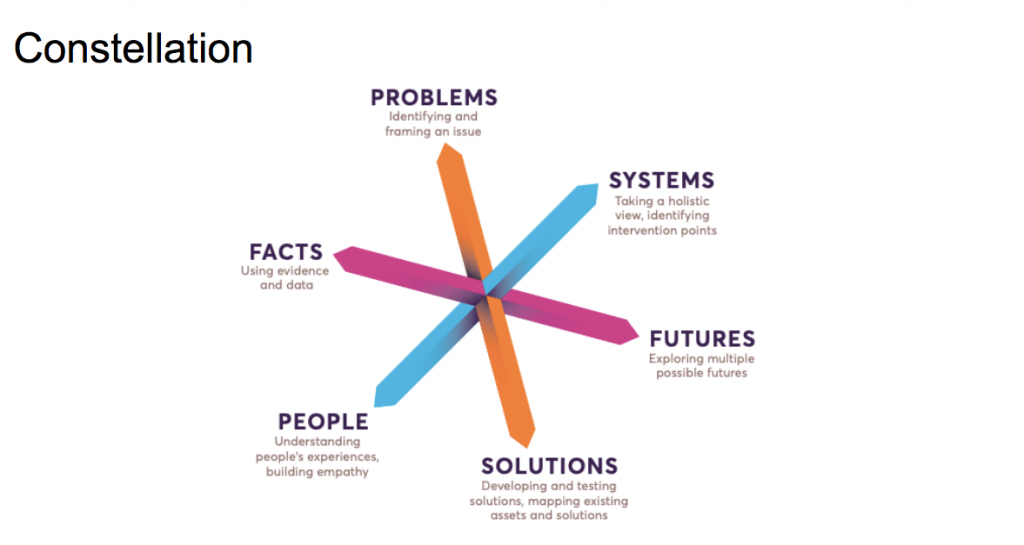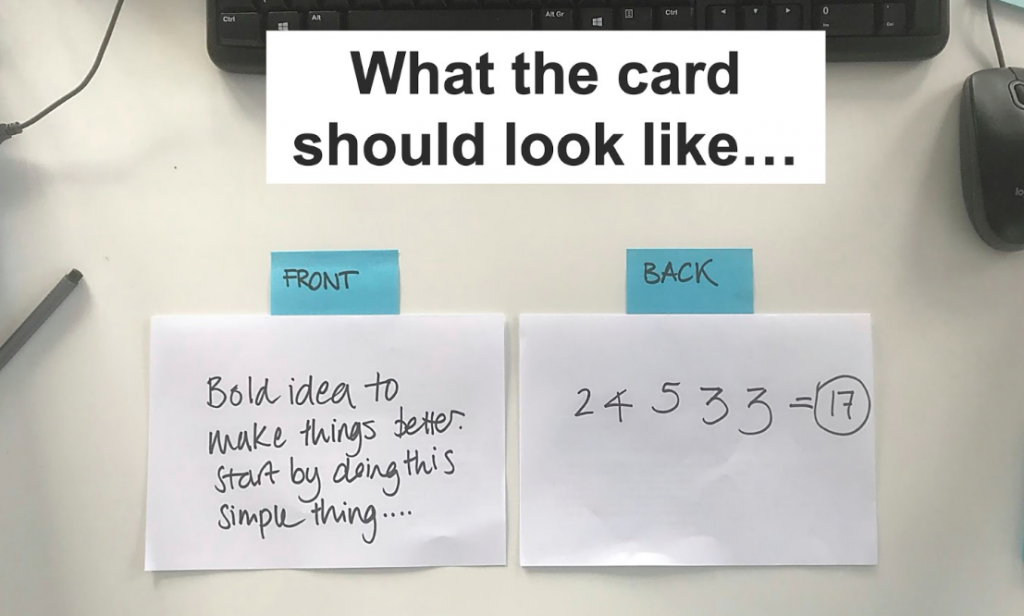This week, I attended a participative event to explore how Liberating Structures can shape Scottish public service change work. It was a really good day, great atmosphere, very relax yet productive. Most participants had been experimenting with Liberating Structures in their work and could share this experience, but it was also about reflecting, as a facilitator, how it can feel for the group we are using it with, especially when they are new to it.
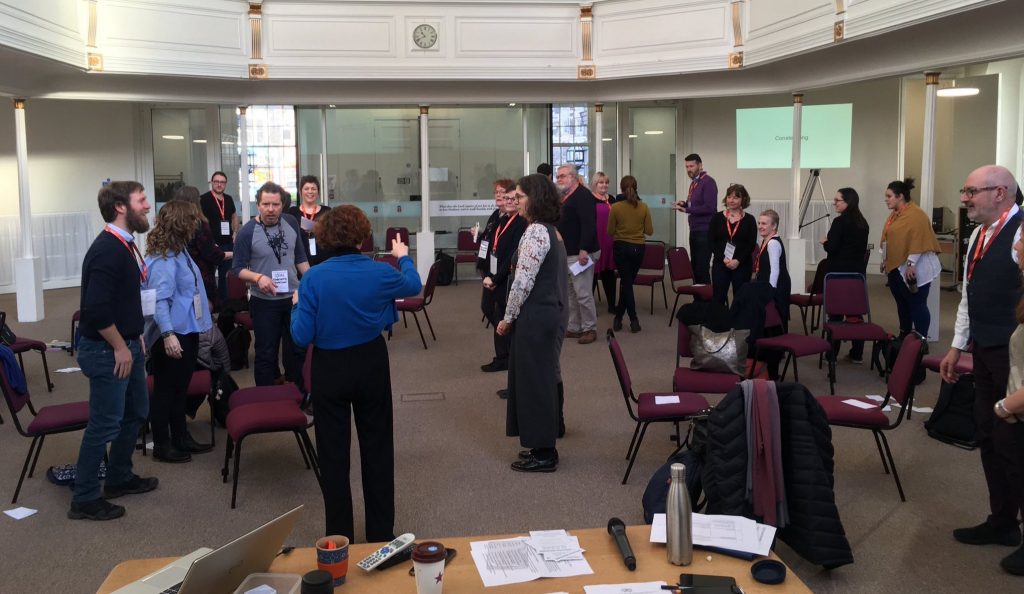
What is a Liberating Structure (LS)?
“Simple rules that make it easy to include and unleash everyone in shaping the future”
– Henri Lipmanowicz and Keith McCandless
When you have a group of people, in a meeting or a workshop, you usually have some with a stronger voice, others who won’t say anything, and some who will follow the flow without really taking part. Decisions and outcomes of the meeting will, most of time, only represent the ideas of the most powerful in the room.
Shaping your meetings differently, by using some tools like the LS, can change this and allows everyone to be heard, share ideas, feel empowered and included.
This is important in your team, but even more when you work with wider groups. If you want your session to be richer and people to fully participate then you need to make sure you include everyone and give them some space where they feel safe to express themselves.
There are a lot of different LS, all easy to learn. Find out more on this website.
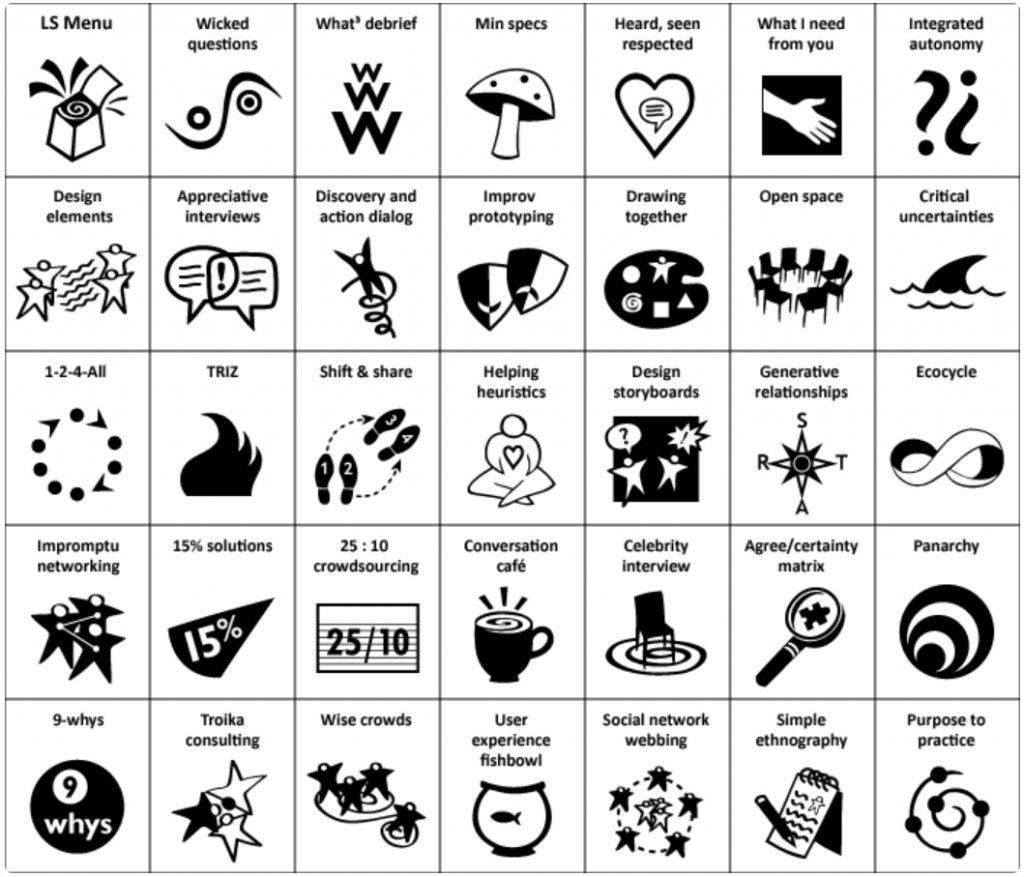
10 Principles
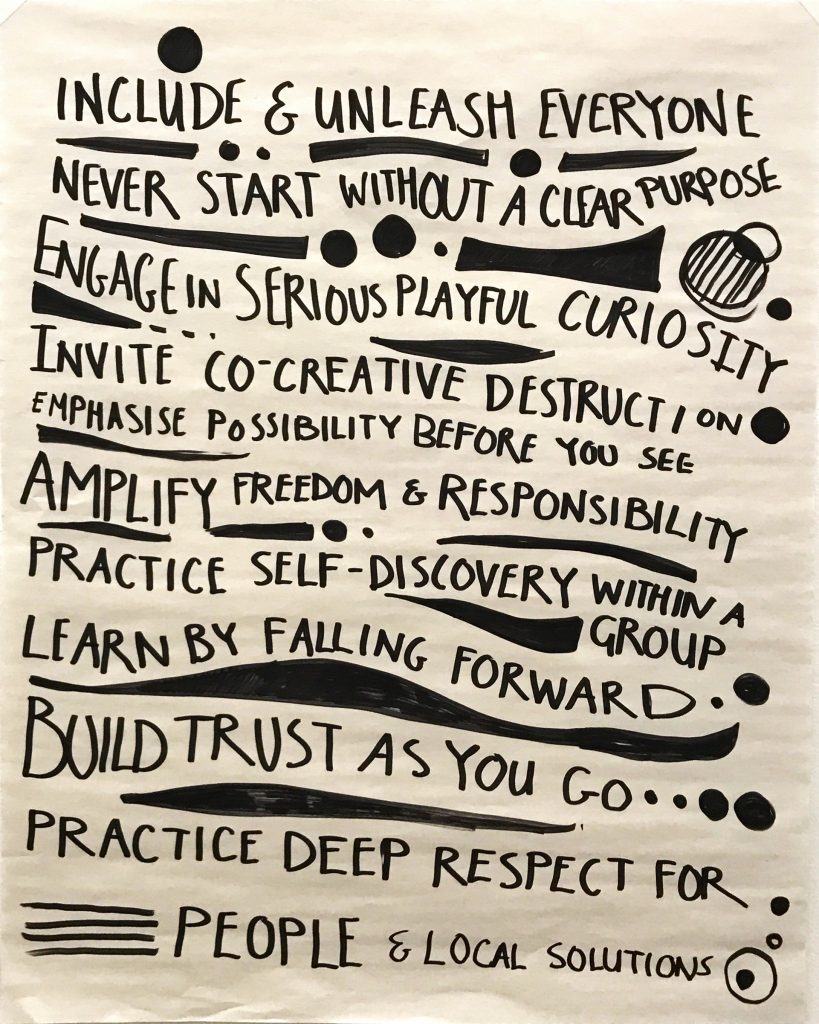
- Include and unleash everyone
- Practice deep respect for people and local solutions
- Build trust as you go
- Learn by failing forward
- Practice self-discovery within a group
- Amplify freedom and responsibility
- Emphasise possibilities: believe before you see
- Invite creative destruction to enable innovation
- Engage in seriously-playful curiosity
- Never start without a clear purpose(s)
What we did on the day
The session was lead by Harriet, Jon, Katy, Leah and Linda. They made sure the atmosphere was really relax, safe and even zen-like with a metal gong sound marking the end of a session or a round. You can see it in the video by Jon below:
Transcript of the video: Liberating structures is an alphabet of tools you can use with people with very simple structure and process but enables everyone to take part and to work through the processes together, to make things happen and have good conversations. There is a range of people in Scotland who have been experimenting with these tools and practices, and today was an opportunity to come together and share what they have been learning over the last year. Some of the joy of that, was not knowing what it was going to be. The main thing for me is around just to getting different people from different worlds together, to share their practice, see the new connection forms, an opportunity forms, and that what has been happening, some fantastic conversations and connections today.
A bit more about the various LS we tried that day:
Impromptu networking
Simply move around, find someone you don’t know, then ask and answer the following questions with 2 minutes each, do 3 rounds, so each participant meets 3 people.
- I’m here because
- Something I’ve been thinking about is
- What I’d like to explore is
Constellations
This is about using the physical space to express yourself, making things visible without having to share. For some people, it’s freeing as they don’t need to speak.
One simple exercice was about placing yourself in the room to represent where you were born, with Scotland being at one end of the room and London toward the stage. This placed me very far from the others and really, I should have been outside the building 😀 Another participant was also by himself (born in Ireland).
An another one was to find ‘your group’ work-wise. It wasn’t that easy for some. The instructions were vague enough to leave room for reflecting about how we felt about where we belong compared to another group, do I join that group, do they accept me as one of them?
Another exercice is illustrated in the photo at the top. We had to place ourselves looking at what we felt we were working with (Problems, Systems, Futures, Solutions, People, and Facts) and then looking toward what we were aiming at. 6 Cards had been put on the pillars in the room to help us place ourselves.
The last one was to place yourself on a line depending on how much experience you had using LS. As I’m pretty new to this (I had only read about it at that point) so I was at one of the extremities. This was then used to form small groups to make Basecamps (next LS used). I initially felt it would be better to have mixed abilities in the group, but the point was to put us at the same level to avoid a power relation in the group. As a novice you could feel less relevant and might not speak as freely, which is something I would not have think of.
Learning Basecamp
The idea was for us to form a small group we would come back to and allow continuous conversations through the day. It was nice to get to know some people better.
Appreciative interviews
In this small group, we started Appreciative interviews: we had a to share a story about a moment at work we had a success with another person in the group, and they will share one in return. Then in the bigger group, we would be the one telling their story to the others. To me, it was a really good way to force you to really listen (as you will have to tell the whole group after) and to ask questions to make sure you really understand it as well.
From this, we tried to find the root causes of the success these stories where telling. Not that easy.
The organisers had picked for us to tell a ‘success story’ as a way to make us feel power automatically from it. This led us to think about power and to recognise when it’s there.
With great power comes great responsibility
Spiderman’s uncle, Ben
Thread about the Appreciative interviews by David Heath worth reading:
3 by 3 writing
This one is about answering 3 questions, 3 times:
- Some of the most memorable ups and downs of my experience with LS have been…
- Three things I’m learning about applying LS in practice are……
- Three things I’ve learned about myself as a facilitator through this have been……
You answer 3 times because the 1st thing that comes to mind is probably what you would say to someone any time, but the more you think about it, the more likely your are to find the deep reason.
This reminded me of the 3 colours sharpies method Kat Husband had written about: No one says no to Sharpies – on Medium. A participant is asked to draw something like “Draw your digital life” and they are given a pen for 2 minutes, then another colour for 2 minutes and a last one for 2 minutes too. This helps understand the participant’s priorities and thought processes.
25/10 crowdsourcing
This one I had already used at the end of a talk at a conference. The speaker had asked the audience to write a question on a paper. Then we mixed the papers in the room by exchanging papers with each other. Then we would mark on a scale from 1 to 5 if it was an interesting question. Then mix the papers again and mark a different one. You do that 5 times, so you end up with all papers with 5 marks at the back which you add, and the questions with the highest total were asked. It’s a good way to get really interesting questions, that the majority of the group got to chose.
On the day, we used it to pick 5 themes we would be interested in discussing as a group. You can see the mixing of the questions cards in the video above. We had 2 very similar questions which came up with high scores at the end and got picked. They both had slightly different total, but to me, it was an illustration of the pretty good chance to have a consensus emerging at the end.
We were then to decide which discussion we wanted to join among the 5 highest score questions card. One question only got one person interested in discussing it. That in itself, was really interesting. It could be because people were more interested in the other questions, or maybe sometime, you might think something is really interesting and at the same time don’t really want to spend time on it?
Open space
The key principles for this one are:
The Law of Two Feet means go and attend whichever session you want, but if you find yourself in a session where you are not learning or contributing, use your two feet!
- Whoever comes are the right people
- Whatever happens is the only thing that could have happened
- When it starts is the right time
- When it’s over, it’s over
We used it to discuss one of the 5 questions as a small group. I took part in a discussion about convincing senior leaders to use LS. Also how to use it in different work cultures. Some of the potential ways to convince people we came up with were:
- by-pass the middle management and try to reach out to the senior leader(s) directly
- practice and get experience with a smaller group before bringing new people to it, especially senior leaders
- find the right space: meeting rooms often do not allow enough space to move around, so try other spaces, in the building or near by
- take advantage of events like employee engagement surveys, or volunteer day to do something different
Another group worked on “how might we make liberating structures more accessible?” below is the outcome of their session:
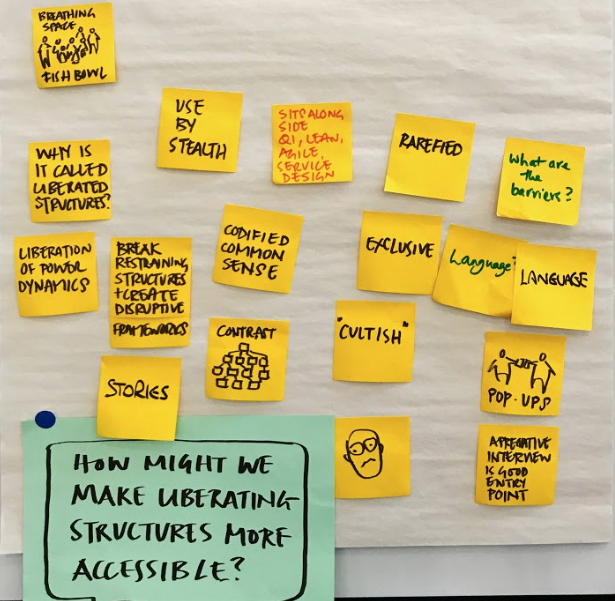
Beautiful notes from Hazel White about the day
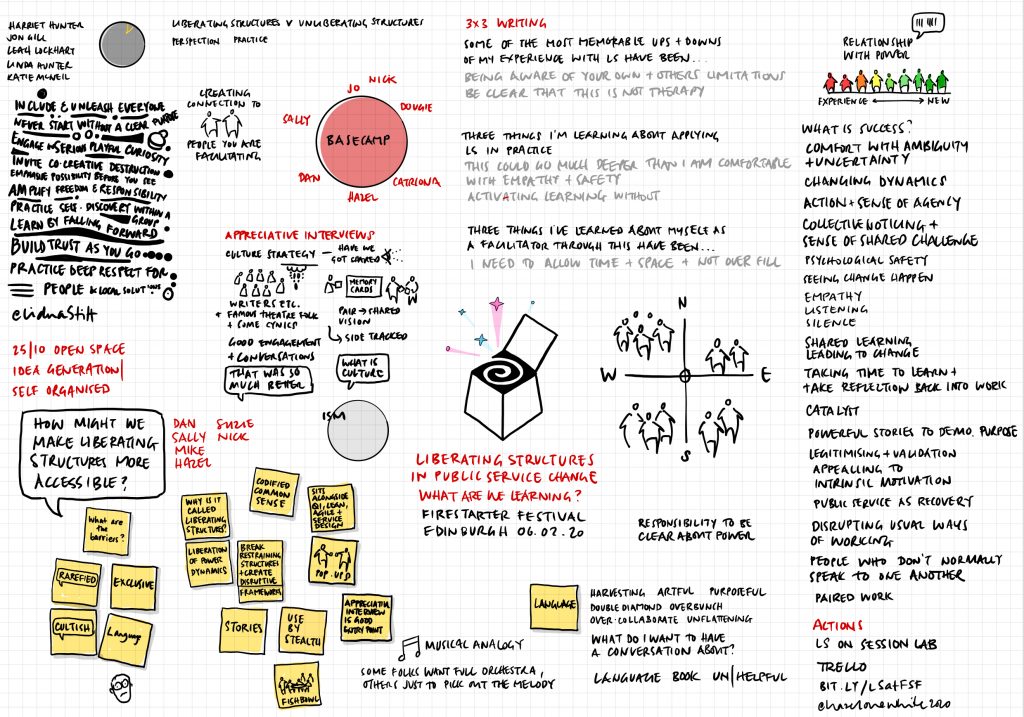
Seven Step Meeting Process
This is not an LS but a concept I learned about with Amanda who was in my basecamp group. It seems to really work for them (Improvement Service in the Scottish Government) and she explained they had better meetings that way.
The Seven Step Meeting Process is a methodology for improving the efficiency and effectiveness of meetings.
The meeting process adheres to the following timed agenda:
- Clarify Aim/Purpose
- Assign Roles (roles rotate from one meeting to the next)
- Review Agenda
- Work through Agenda
- Review meeting record
- Plan Next Steps and Next Agenda
- Evaluate
There are 4 roles to be assigned (in step 2):
- Leader – not a power position. The leader’s role is to start the meeting, ensure that the agenda is followed with smooth transitions between agenda items and to conclude the meeting.
- Recorder – The recorder role is crucial to ensure that key ideas, themes and actions are recorded for all to see.
- Timekeeper – The time keeper should follow a rule of 50%. If an agenda item has been allocated 10 minutes:
-the timekeeper will call out “5 minutes left” at the halfway point,
-then “two and a half minutes left”,
-then “one-minute left”,
-then “time!” - Facilitator – this is a challenging role and may not be required for every group situation. The facilitator will observe the meeting progress ensuring that all participants have an opportunity to contribute and that the group remains focussed on the agenda and the process.
Learn more about Liberating Structures
There is a lot on this website: liberatingstructures.com
On Twitter: @LiberatingStru1 for Scotland, @LibStructLDN for London or @LSEurope for Europe
On Slack: liberatingstructureslondon.org.uk/slack – there is a French channel there. That will be the first time I can interact on Slack in French.
3 articles worth reading
- Liberating Structures for Design on Medium by Mike Press (this is the first time I’ve heard about LS – Thanks Mike!)
- How to use Design Thinking & Liberating Structures for High Stakes Decision Making – on LinkedIn by Takeshi Yoshida – He mentions in more details his favourite LS: 1-2-4-All, Min Specs, DAD (Discovery & Action Dialogue), Ecocycle Planning, 25/10 Crowd Sourcing, 15% solutions, WINFY (What I Need From You), W3 (What, So What, Now What)
- Liberating Structures Are Skills To Be Learned By Users, Not Facilitators on Medium by Christiaan Verwijs
To finish
I thoroughly enjoyed the day, met new people, like David, had rich discussions, got to know Hazel and Mike better, caught up with Leah, and had really nice chats with Suzi, Sharon, Amanda, Lea, and Dan among others.
By joining the Slack workspace and following new people on Twitter after this event, I’m already full of new ideas and learning loads.
Getting better at facilitating sessions, trying co-design and better collaborations are on my list of goals in my professional life, but I’m also really interested in finding alternative ways for citizens to be involved in politics. Liberating Structures are definitely something worth exploring further.
Big Thank You to the 5 organisers: Harriet, Jon, Katy, Leah and Linda + to all the participants who made this day so good!
You might also be interested in this blog post: Self-organisation — How do we give the power back to the people?
